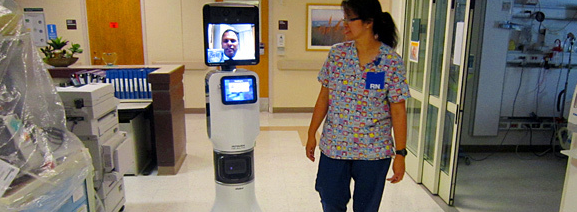
First published in the Harvard Business Review
No matter how many creative solutions we drum up to improve quality of care and service in the U.S. health system, they won’t do much good if only a few clinicians and institutions know about them and apply them.

First published in the Harvard Business Review
No matter how many creative solutions we drum up to improve quality of care and service in the U.S. health system, they won’t do much good if only a few clinicians and institutions know about them and apply them.
But how do you overcome obstacles to spreading innovation, like fear of change, resource constraints, and slow, consensus-based decision making? By connecting people so they can quickly and easily share insights, collaborate on prototypes, and draft off one another’s enthusiasm and momentum. As Atul Gawande put it in a recent New Yorker article, “Human interaction is the key force in overcoming resistance and speeding change.”
That’s what I focus on in my role at Kaiser Permanente: creating opportunities for cross-pollination between innovators and promoting their successes and lessons learned, both internally and externally. I conduct interviews with innovators at the company, create fact sheets and videos about their work, write articles, and share all that content with various groups of clinicians and staffers. (For instance, here’s a video about providing patients with real-time access to care and their personal health information, regardless of where they are.) That’s the grassroots part of my job. I also prepare our C-suite executives with stories and statistics so they can promote innovation through the ranks and out to the rest of the world through speeches, media exposure, and conferences.
Here’s an example that shows how well this combination of bottom-up, top-down communication can work when you’re trying to spread a health care idea:
Telemedicine on wheels
ICU doctors at the Kaiser Permanente Fremont Medical Center in Silicon Valley did a proof-of-concept pilot for the InTouch Health system, which is essentially a roving telemedicine robot. It allowed physicians to be present without being physically there in the late evening hours, after their shifts had ended. All at once they could interact with patients through video, access records electronically, and move around the facility on wheels, by remote control.
During the three-month pilot, the center reported fewer night emergencies because the ICU physicians were able to catch issues before they became big problems. The physicians formed stronger relationships with the evening shift nurses, partnering more closely with them during their rounds (before, night nurses had rarely interacted so directly with the ICU doctors). This improved care by building trust between doctors and nurses, and by enhancing nurses’ diagnostic skills as they worked alongside doctors to spot issues before they turned into emergencies. Family members visiting in the evenings also valued the chance to talk to doctors, increasing patient and family satisfaction.
Despite these clear gains, the program stalled for several months while leaders in the organization continued to deliberate on the pilot, since the contractual process for bringing a new technology vendor on board had to be managed carefully. To facilitate the partnership, Jenny Cunha, an improvement adviser at the Fremont center, networked extensively with clinicians and executive leaders throughout Kaiser Permanente, working with legal teams to help address hurdles. She also blogged internally about the pilot’s results, lessons, and protocols.
And my team helped her showcase the InTouch machine through interactive museum-type “Imaginariums” at two large Kaiser Permanente events: the National Diversity Conference and the National Quality Conference. That gave hundreds of leaders, physicians, nurses, and other frontline staffers a chance to try out the technology and hear Jenny’s story. Attendees got to test the system’s high-fidelity two-way video camera, audio, stethoscope, 20-inch TV screen, and rolling wheels for themselves, which helped to allay concerns about the reliability of the interaction.
Immediately after the first Imaginarium, I wrote an article about it and created a video of people interacting with the technologies featured there (paying special attention to the roving telemedicine robot) for an internal digital newsletter that goes out to Kaiser Permanente’s 175,000 employees. I also worked with a visual storyteller to create an animated whiteboard video to educate clinicians and innovators at the National Quality Conference about the steps in the innovation journey: demos, small tests, further exploration, and larger tests. And I provided content for then-CEO George Halvorson so he could highlight the telemedicine pilot in his weekly letter to all employees. His letter linked readers to the video and full article.
My team then invited Jenny to the Kaiser Permanente Innovation Retreat in May to network with other clinicians and innovators, share her story, and build support among attendees.
Those combined efforts sparked more than 30 requests for further information, in-person site visits to Jenny’s ICU, and technology demos. As a result, more people learned about the benefits this system could bring, asked good questions, contributed their own expertise and input, and improved the program overall.
The InTouch program has begun to spread. A Kaiser Permanente emergency department in the Pacific Northwest bought two video telemedicine carts on wheels, and Kaiser Permanente medical centers in Southern California are considering getting an InTouch unit.
Spreading innovation at your company
When you’re trying to get ideas moving in your health care organization, how do you avoid roadblocks? You can’t always, says Christi Zuber, director of Kaiser Permanente’s in-house design thinking group. But she suggests these steps:
1. Examine how the idea you’re trying to promote directly improves the organization’s ability to deliver high-quality care, and whether the idea is actually ready to go. Even if the benefits are clear, it can take months to build the organizational capabilities and support to get an idea off the ground. For example, it took Jenny Cunha six months to launch her pilot program in the ICU after first seeing roving video telemedicine machines at a Kaiser Permanente technology spotlight event.
2. Make sure people on the front lines have the bandwidth and tools to implement your idea. Sometimes what appears to be resistance is really a lack of time to do the planning and carry it out. You can ease the logistical burden by creating a “change management packet,” with videos of new innovations that can be incorporated into the workflow, concept sheets with data and lessons learned, templates to help teams customize new processes, and tools such as revised care boards and new hourly rounding sheets. (Kaiser Permanente’s Innovation Consultancy published an article on how to do this in the International Journal of Design.)
3. Encourage innovators at your company to share their best practices and lessons with other teams and departments, as Jenny did. In addition to blogging, she sent bimonthly email updates to pilot sponsors and other curious followers, did dozens of demos, and posted photos and information on a cork board in her medical center.
Any idea you present may take time to gain traction. If it’s immediately accepted by all decision makers, it probably isn’t all that innovative. If it’s rejected, wait and try again. Or re-examine the idea: Does it really improve quality of care? How?
New technologies, digital health tools, and care-delivery models are emerging fast. The landscape may not be ready for your innovation today—but it might be six months from now.








